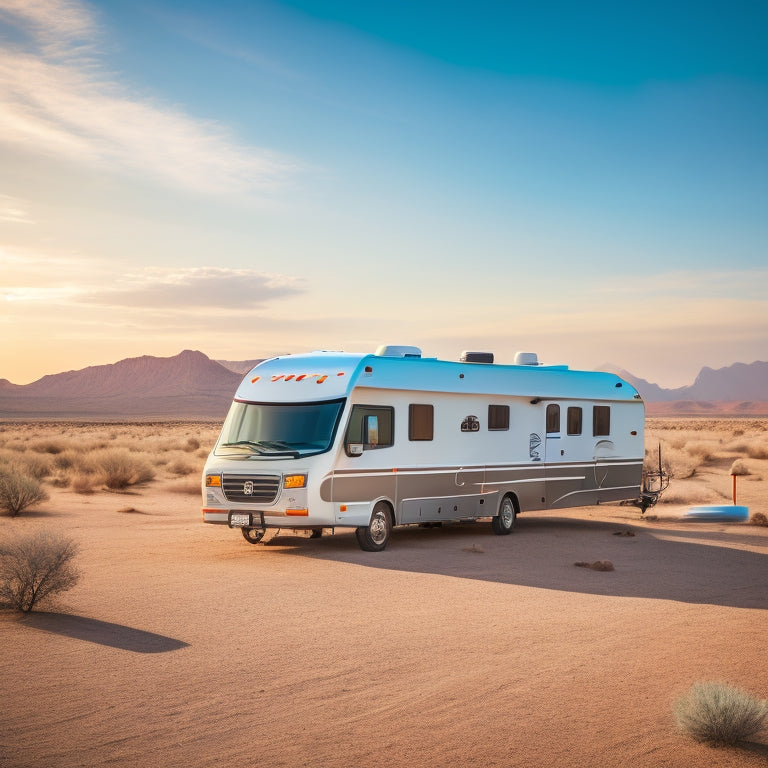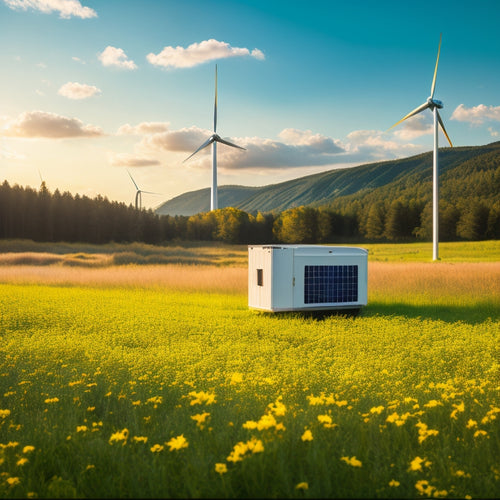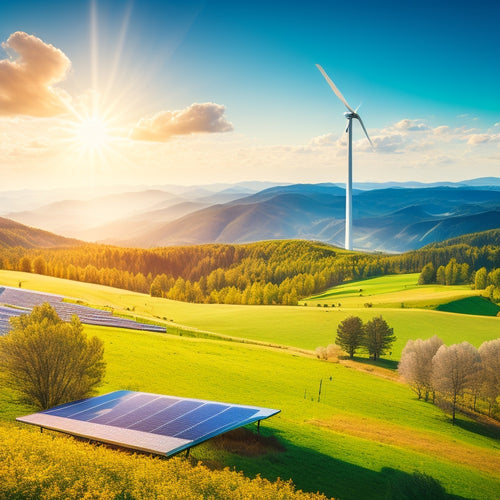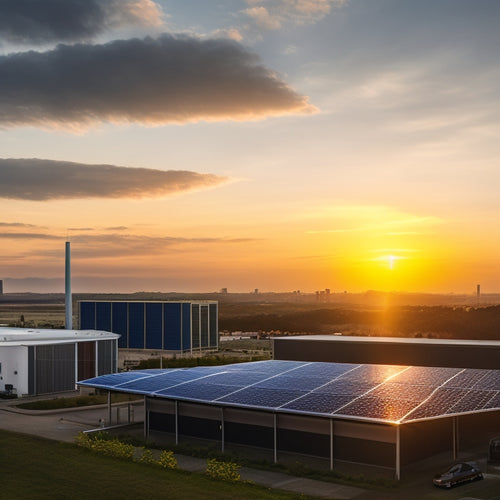
RV Air Conditioning on Renewable Energy
Share
You can power your RV's air conditioning system using renewable energy by utilizing solar power, which enables off-grid camping without relying on grid power limitations. To do this, you'll need to calculate your energy requirements by identifying the AC wattage and usage hours, then selecting the right solar panels and sizing your array correctly. You'll also need to choose a suitable battery and inverter, considering factors like efficiency, discharge cycles, and compatibility. By accurately sizing your system and following installation and maintenance tips, you'll be able to enjoy reliable AC operation on the road, and exploring the details of each component will reveal the full potential of renewable energy for your RV.
Overview
- Strong solar panel systems and deep-cycle battery banks are necessary for off-grid RV air conditioning on renewable energy.
- Accurate calculations of energy requirements and peak usage ensure sufficient power for cooling needs in RVs.
- Solar panel efficiency, available roof space, and inverter sizing are critical considerations for meeting RV energy requirements.
- Properly sized inverters and compatible battery types, such as lithium or lead-acid, are essential for reliable AC operation.
- Regular maintenance, including inspecting air filters and refrigerant levels, is necessary for optimal RV air conditioning performance on renewable energy.
Solar Power for RV Air Conditioning
When you're boondocking or dry camping, relying on solar power for your RV air conditioning can be a game-changing factor.
You'll need a strong solar panel system to generate enough energy to power your AC. With off-grid solar power, you can camp anywhere, free from grid power limitations power independence, and enjoy the freedom to investigate secluded areas without sacrificing convenience.
There are three main solar panel types to evaluate: monocrystalline, polycrystalline, and thin-film. Monocrystalline panels are the most efficient, but also the most expensive. Polycrystalline panels offer a good balance between efficiency and cost. Thin-film panels are the most budget-friendly option, but they're less efficient.
Regardless of the type you choose, you'll also need a suitable energy storage system to store excess energy generated during the day for use at night or on cloudy days. A deep-cycle battery bank with a high capacity rating is essential for reliable energy storage.
Calculating Energy Requirements
You've determined that solar power is a viable option for your RV air conditioning, but now it's time to get down to business and calculate your energy requirements.
To do this, you'll need to determine your RV's energy consumption. Start by identifying the wattage of your air conditioning unit and the number of hours you expect to run it daily. Multiply these values to get your daily energy consumption in watt-hours (Wh).
When selecting a DIY solar power system, consider key considerations such as high-efficiency panels and reliable inverters to guarantee a successful installation.
Next, consider your peak usage - the maximum amount of energy you'll need at any given time. This will help you size your solar panel array and battery bank correctly.
Accurate calculations are vital to confirm you have enough power to meet your cooling needs while maintaining your freedom on the open road.
Choosing the Right Solar Panels
You'll need to select solar panels that meet your RV's energy requirements, which means considering panel efficiency, as even small gains can add up.
To guarantee ideal energy harvesting, it's vital to evaluate daily energy usage and roof space for appropriate inverter sizing Energy Requirements and Sizing.
You'll also need to think about the physical constraints of your RV, as larger, heavier panels may not be feasible.
Panel Efficiency Matters
Selecting the right solar panels for your RV's renewable energy system hinges on understanding panel efficiency, a critical factor in determining how much power you can generate from a given surface area.
You'll want to take into account the type of panel that best suits your needs. Monocrystalline panels, for instance, offer higher efficiency rates than polycrystalline panels, but at a higher cost.
Thin-film panels, on the other hand, are more budget-friendly but less efficient. When it comes to energy conversion, look for panels with high power output per unit area.
This guarantees you maximize energy production while minimizing space. By choosing the right panel type, you'll be able to generate more power and enjoy the freedom to roam without worrying about your energy supply.
Size and Weight Considerations
As you consider the right solar panels for your RV's renewable energy system, size and weight become critical factors, particularly when roof space is limited and payload capacity is a concern.
You'll want to optimize weight distribution to maintain a stable and secure RV. Look for compact designs that maximize energy output while minimizing physical space.
A well-designed solar panel should provide a high power-to-weight ratio, guaranteeing you get the most energy from a smaller, lighter package.
Be certain to check the specifications of each panel, considering both the weight and dimensions to guarantee a safe and efficient installation.
Compatibility and Integration
With your RV's renewable energy system in mind, it's essential to choose solar panels that seamlessly integrate with your existing setup.
You'll want to guarantee the panels' energy management system is compatible with your alternative cooling solution, allowing for efficient optimization of your off-grid energy needs.
Consider the system integration and how it will impact your sustainable living experience.
Look for solar panels that incorporate the latest technology advancements, factoring in climate considerations and your specific RV setup.
Sizing Your Solar Array Correctly
Properly sizing your solar array is essential to guaranteeing your RV's air conditioning system can run reliably on renewable energy.
When sizing your solar array, you'll need to take into account your energy requirements, solar panel orientation, and seasonal energy variations. For instance, if you're camping in the summer, you'll need more energy to power your AC unit, so you'll require a larger solar array.
Conversely, in the winter, you'll need less energy. Confirm your solar array is tilted correctly to maximize energy production, and take into account the direction of your solar panels to optimize energy output.
Battery Selection for AC Units
Three essential factors - depth of discharge, capacity, and type - determine the suitability of a battery for powering your RV's air conditioning unit on renewable energy. You need a battery that can handle the demands of your AC unit while providing reliable performance over time.
| Battery Type | Capacity (Ah) | Discharge Cycles |
|---|---|---|
| Flooded Lead-Acid | 200-400 | 300-500 |
| AGM Lead-Acid | 200-400 | 500-800 |
| Lithium-Ion | 100-200 | 2000-3000 |
When selecting a battery, consider lithium options for their high discharge cycles and efficient charging. However, they come at a higher cost. Regardless of the type, maintain your batteries by monitoring their temperature, state of charge, and charging efficiency. This will guarantee you get the most out of your investment and enjoy the freedom to camp off-grid with reliable air conditioning.
Inverter Compatibility and Sizing
When selecting an inverter for your RV's air conditioning system, you'll need to evaluate the type of inverter that best suits your needs, whether it's a pure sine wave, modified sine wave, or square wave inverter.
You'll also need to verify the inverter is properly sized to handle the AC unit's surge and continuous power requirements for efficient operation.
To do so, you'll need to accurately calculate the load, considering factors such as the AC unit's power consumption, compressor type, and any additional loads.
Inverter Types Compared
Selecting the right inverter for your RV's renewable energy system is essential, as it directly affects the overall performance and efficiency of your air conditioning.
You'll find three main inverter types: modified sine wave, pure sine wave, and grid-tie inverters. Modified sine wave inverters are the most budget-friendly, but may not be compatible with all air conditioning units. Pure sine wave inverters offer high inverter efficiency and are compatible with most appliances, but come at a higher price.
Grid-tie inverters are ideal for grid-connected systems, but not suitable for off-grid RV use. When choosing an inverter, consider factors like inverter features, inverter brands, and inverter pricing.
Additionally, think about inverter installation, inverter lifespan, and inverter maintenance requirements. Look for inverters with advanced inverter technology, easy inverter upgrades, and reliable inverter troubleshooting support.
Sizing for Efficiency
As you configure your RV's renewable energy system, accurately sizing your inverter is essential to guarantee efficient air conditioning performance.
A correctly sized inverter guarantees that your cooling strategies run smoothly, conserving energy and reducing strain on your system.
When selecting an inverter, consider the maximum power requirement of your air conditioning unit and the available energy from your renewable sources.
Verify the inverter can handle the surge current during startup and maintain a stable output voltage.
Oversizing your inverter can lead to energy waste, while undersizing can cause system failure.
Load Calculation Tips
Accurately calculate your RV's air conditioning load to guarantee a compatible inverter size.
You'll need to determine the total cooling capacity required to maintain a comfortable temperature. Consider the RV's size, insulation, and climate zone to estimate the heat gain.
Don't forget to factor in the energy efficiency of your air conditioning unit. A higher EER (Energy Efficiency Rating) means less power consumption.
Next, calculate the maximum power draw of your air conditioning unit, usually found in the user manual. Ascertain your inverter can handle this load by sizing it accordingly.
A correctly sized inverter will prevent overheating and assure reliable operation.
Installation and Maintenance Tips
You'll need to carefully plan the installation of your RV air conditioning system to guarantee it runs efficiently on renewable energy. When selecting installation techniques, consider the system's power requirements and the available space in your RV.
Make certain that the equipment is securely fastened to withstand vibrations and movements. Properly seal all electrical connections to prevent water ingress and corrosion.
Create a maintenance schedule to confirm your system runs at peak performance. Regularly inspect and clean the air filters, condenser coils, and fans to prevent dust buildup.
Check the refrigerant levels and electrical connections for signs of wear or damage. By following these installation and maintenance tips, you'll enjoy reliable cooling on the road while minimizing your reliance on fossil fuels.
Frequently Asked Questions
Can I Use a Single Solar Panel to Power My Rv's AC Unit?
You're wondering if a single solar panel can power your RV's AC unit; however, considering solar panel efficiency and your RV's power consumption, it's unlikely, as AC units demand high power, and a single panel might not meet that demand.
Will My Rv's Batteries Drain Quickly With Constant AC Use?
When you're burning the midnight oil, you'll want to know if your RV's constant AC use will drain your batteries quickly. It depends on your battery capacity and energy efficiency - with a well-sized system, you'll have the freedom to stay cool without running on fumes.
Are There Any RV Air Conditioning Units Specifically Designed for Solar Power?
You'll find solar AC models designed for energy efficiency, such as the Coleman Mach 8, which optimize performance on lower wattage, making them suitable for solar power systems, giving you the freedom to stay cool off-grid.
Can I Install a Solar Array on My Rv's Roof Myself?
You can install a solar array on your RV's roof yourself, but it's essential to guarantee a secure and efficient DIY solar setup by carefully planning the solar panel installation, considering factors like weight, durability, and electrical compatibility.
Will a Solar-Powered AC Unit Increase My Rv's Insurance Premiums?
When you add a solar-powered AC unit, you're modifying your RV's electrical system, which may impact insurance coverage. You'll likely face premium adjustments, but the extent depends on your provider's policies and the system's installation, so research and disclose the changes to your insurer.
Ready to Buy
As you wrap up your RV air conditioning setup on renewable energy, it coincidentally clicks into place - solar panels capturing the sun's power, batteries storing excess energy, and an inverter ensuring a seamless conversion. Your calculations and careful component selection have paid off, allowing you to enjoy the comfort of cool air while reducing your carbon footprint. With regular maintenance, your system will hum along, a orchestration of sustainability on the open road.
Related Posts
-

Sustainable and Eco-Friendly Generators for a Reduced Carbon Footprint
Sustainable and eco-friendly generators are perfect for cutting your carbon footprint and increasing energy efficienc...
-

Renewable Energy Solutions to Reduce Your Carbon Footprint
To reduce your carbon footprint, adopting renewable energy solutions is key. Using solar panels or wind turbines can ...
-

Advantages of Commercial Solar Battery On-Site Storage
By investing in a commercial solar battery on-site storage system, you can greatly reduce your energy grid dependence...


